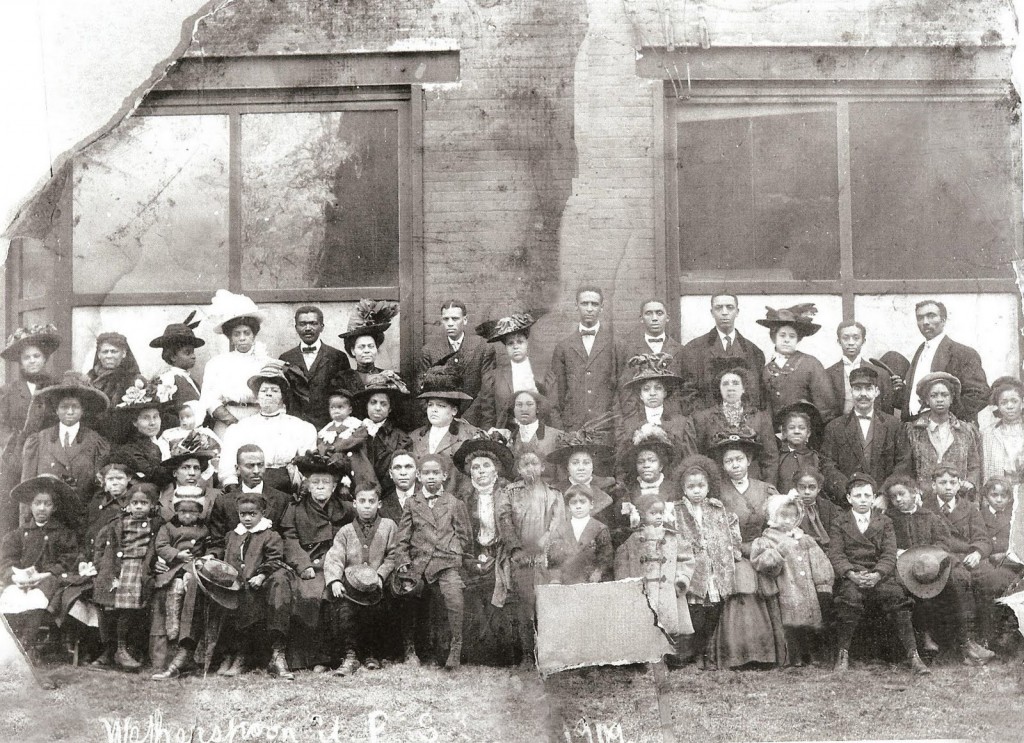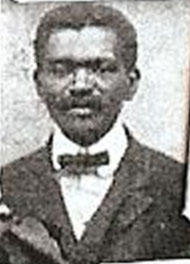
James Cleage was born in 1870, the eighth of the ten surviving children of formerly enslaved Jerry and Charlotte (Bridgeman) Cleage. His parents had been enslaved on David Cleage’s plantation before the Civil War. Neither Jerry nor Charlotte learned to read or write. Jerry worked as a laborer until his death at age 92.
In September 1894, twenty-two year old James Cleage married twenty year old Josie Cleage. Although they were both named Cleage, it was not because they were related. Josie’s family was enslaved on Alexander Cleage’s plantation while James Cleage’s family was enslaved on David Cleage’s plantation and both families took the surname of “Cleage”. Both were born after the Civil War.
They had six children – Henrietta born in 1897, Lucille in 1899, James in 1901, Albert David in 1907 and Hattie Ruth was born in 1909. One child was born and died between censuses and I do not know if it was a boy or girl or their name.
James seems to have been the only one of his siblings to get an extensive education. In April 1890 Jacob Lincoln Cook, came to Athens to establish a Presbyterian Mission and founded the Athens Academy. James Cleage was one of the small group of dedicated educators that worked with him and taught there in the early years. In 1900 James was 29 and teaching school at the Athens Academy. He and his family were living next door to his wife’s mother, step-father and her younger brothers.
In 1900 J.L. Cook was appointed president of Henderson Normal Institute in Henderson, North Carolina. James also went to North Carolina and began teaching at the Institute. In 1901 Josie and James son, James Oscar, was born there. My grandfather, Albert Cleage, lived with his aunt’s family while he was attending high school at Henderson Normal. He graduated in 1902. By the time Albert David (called David) was born in 1907, the family was back in Athens, Tennessee, but not for long.
By 1905 Henry and Jacob Cleage had relocated to Indianapolis, Indiana and in 1908 James, Josie and their growing family joined them there. Their youngest daughter, Hattie Ruth was born in Indianapolis in 1909. James worked as mailing clerk for The Indiana Farmer. Here is a link to the January 2, 1909 issue of that paper. Josie stayed home and raised the children and kept the house.
Both James and Josie were active in Witherspoon Presbyterian Church. I found these short items in the Indianapolis Star “News of The Colored Folk” during 1911.
March 11, 1911
Officers of the Witherspoon United Presbyterian Church entertained its members at the church at a banquet Tuesday night. Dr. H.L. Hummons was toastmaster. Addresses were made by Henry and James Cleage, Mrs. Lillian T. Fox and Mrs. M.A. Clark.
April 9, 1911 Sunday
The Witherspoon United Presbyterian Church will give its annual musicale Friday evening at the church on North West street. The following program will be given: Solo, Mrs. T.A. Smythe; reading, Mrs. James Cleage; clarinet solo, Philip Tosch; reading, Mrs. Harriet Mitchel; quartet, Messrs. Lewis, Thompson, Chavis and Thompson. The church choir will render three selections. Mrs. Daisy Brabham has charge of the program.
My father and his siblings regularly traveled from Detroit to visit their cousins in Indianapolis. My aunt Anna remembered her uncle James as a very quiet, gentle man who helped around the house.

The children all finished several years of high school and then got married or started working or both. Lucille seems to have been the first to relocate to Detroit where her uncles Albert, Jacob and Henry Cleage had settled.
James A. Cleage was 62 when he died from prostrate problems in Indianapolis City Hospital on October 21, 1933. He is buried in New Crown Hill Cemetery.
After he died Josie also moved to Detroit. In 1940 she lived with her son David and his family on the Old West Side of Detroit, not far from her brothers.
Other posts about this branch of the family.

Famiy History – ❤️ ❤️❤️ Thank You
Wonderful! <3 <3
Having readers like you two is so encouraging to me.
Just also reread your history of his parents. That James was educated and teaching others after his parents had no such opportunities shows great determination and transformation.
I thought it was especially so because none of his siblings seem to go in that direction. I wonder what made the difference for him.
This is so excellent, telling of the geographic changes of family members…all of which meant family connections were changing as well. Thanks for sharing all these details. I had to look up Henderson NC, because I live near Hendersonville NC…but they are a long way apart.
I find the doors that opened for other family members as moves took place very interesting and it continues to this day.
It’s impressive that James Cleage lived to be 92. I’m always fascinated when I read about someone who lived such a long life many years ago. It makes me wonder about how they reached such an old age in the days before modern medicine.
James only lived to 62, it was his father, Jerry Cleage, who lived to be 92. There were several from that community who lived very long lives. They gave testimony in most of the pension files. It is amazing.
I automatically keep putting Eliza in my email folder to read your narratives whenever I get the chance. Thank you for sharing your family history. It has encouraged me to keep a journal of narratives of my family
I love that I inspired you to keep your family narrative!
My grandparents are 3rd(Pearl Reed) and 4th (Albert Cleage) from the RIGHT
I must know you, since you know which were really my grandparents. And I can probably guess who you are… Thank you for the correction.
Kristin – Boxwood street – Detroit MI. Between Tireman Ave and Moore Place. My grandparents (father) lived near Tireman Ave on Boxwood. I think your relatives lived on Boxwood near Moore Place.
My grandparent’s lived on Scotten between Milford and Moore Place. David Cleage and his family, plus Aunt Josie, lived at 4311 Scovel in the 1940 census. In 1940 your family is listed at 4408 Tireman. The Mullins lived at 4345 Tireman. All of these houses were just a few blocks apart.
Try Again!
Witherspoon United Presbyterian Church Congregation. James Cleage is in the back row, 5th from the LEFT. My grandparents are 3rd(Pearl Reed) and 4th (Albert Cleage) from the RIGHT. My grandfather’s brothers, Jake and Henry Cleage are next to him.
And your guess would probably be correct! E
Wish me luck. I thought I changed it once, but apparently I did not. I know I changed both this time.
Kristin – Detroit map (1940) – 6515 Boxwood. Henry and Ola Cleage.
Don’t know how that happened! 6515 Boxwood. Henry and Ola Cleage.
Whew! Okay, so there was family on Boxwood. Your people were Walkers, right?
Kirstin – 6612 Boxwood.
So, they were practically next door to Henry and Ola.
Kristin – So, what’s the Old West Side? To me – It’s the West Side. In the old Goodfellow games played at the U of D stadium it was the Catholic league West side vs. the East side Champions. The Detroit Public School league it was the West side vs. the East side Champions. It’s the West Side.
Old West Side I found this online “The Tireman community — named for the main thoroughfare passing through it — was one of Detroit’s first African-American enclaves. As with the better-known Black Bottom on Detroit’s near East Side, the restrictive covenants on deeds that barred blacks from buying homes in most of the city weren’t in place here.” https://www.metrotimes.com/detroit/west-side-story/Content?oid=2183353 . Also here https://books.google.com/books?id=rLK1DgAAQBAJ&pg=PT118&dq=%22old+west+side%22+%22detroit%22&hl=en&sa=X&ved=0ahUKEwiXgOXgrJbgAhXlqVQKHTYeBcsQ6AEILjAB#v=onepage&q&f=false
Kristin – I got my football games confused. The Catholic league east side vs. west side at U of D stadium was called the “Soup Bowl” Game. The winner of that game played the winner of the Public School league championship game in the “Goodfellow” game at old Briggs stadium (Home of the Detroit Lions and Tigers) on Michigan Avenue. There were restricted covenants that covered everything north of Tireman Avenue. Larchmont, Seabolt, Spokane etc. In 1945 I rode my tricycle on Firwood to Seabolt. As rode along Seabolt – some man yelled – “Go back to your own street you little nigger!” As a five year old kid – it was educational and a shock! Never forgot that experience.
In the late 1950s or early 1960s, my sister and I rode our bikes out Tireman and came to a white neighborhood (who knew it was even there?) and were called “niggers” by some white boys about our age. We didn’t ride that direction again.